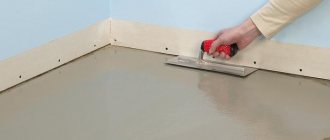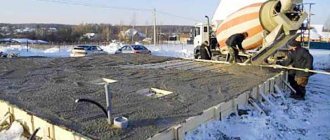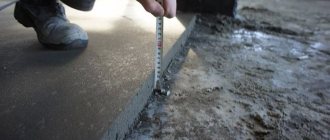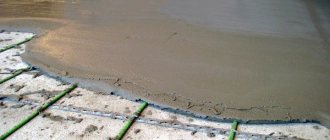The question of how long concrete takes to dry is of interest to any builder, since the duration of construction work depends on the time of setting and hardening of the mixture. Regardless of the type of object under construction, be it a temporary shed, a garage or a multi-story building, compliance with the hardening time allows you to create a structure that has standard strength parameters. If you know the exact curing time, you can competently plan construction processes and effectively optimize the construction time of buildings.
Stages of drying concrete mortar
Hardening of the solution occurs due to hydration, that is, a reaction that, after pouring, begins to occur between water and the binder components of the mixture. The essence of the chemical process is to convert the constituents of concrete into calcium hydrosilicate, which, after final drying, forms a monolithic base with high strength parameters.
To determine the time for complete hardening of concrete, it is important to understand that all reactions that occur in the composition are conditionally divided into two stages:
- Setting
occurs approximately an hour after mixing. During this period, the elements of the solution react, and the mixture itself begins to lose its mobile and plastic properties. - Hardening
- implies crystallization of the solution with a branded set of rigidity and strength. Hardening times depend on weather conditions, proportions and quality of the solution components.
Artificially increasing the rate of hardening
The hardening time of cement mortar in cold weather increases greatly, but the time frame still remains limited. To speed up the procedure, various techniques have been developed.
BITUMAST Anti-frost additive for concrete
In modern construction, drying time can be accelerated by:
- adding additives;
- electric heating;
- increasing the required proportions of cement.
Using Modifiers
The easiest way to complete work on time even in winter is to use modifiers. When a certain proportion is added, the hydration period is reduced; when using some additives, hardening occurs even at -30°C.
Conventionally, additives that affect the rate of hardening are divided into several groups:
- type C – drying accelerators;
- type E – water-substituting additives with accelerated hardening.
The foundation hardening calculator and reviews show maximum effectiveness when potassium chloride is added to the solution. The material is consumed economically, since its mass fraction is up to 2%.
If you use type C concrete curing mixtures, you should take care of heating, since they do not protect against freezing.
Plasticizers and additives for concrete
It is recommended to take care of laying communications in the foundation or screed in advance, otherwise drilling holes will be required. Making communication holes after hardening will require a special tool and grinding of the concrete surface. The procedure is quite labor-intensive and reduces the strength of the structure.
Concrete heating
Mostly, a special cable is used to heat the composition, which converts electric current into heat. The technique provides the most natural way of hardening. An important factor is the need to follow the instructions for installing the wire. The method protects against liquid crystallization; there are also tools (hair dryer, welding machine) and thermal insulation to protect against freezing.
Increasing cement dosage
Increasing the cement concentration is used only with a slight decrease in temperature. It is important to increase the dosage in small quantities, otherwise the quality and durability will be significantly reduced.
How long does it take for concrete to set?
The setting stage of the solution lasts a short time. On average, for the most popular brands (M200, M300) it does not exceed 1 hour at a temperature of +20°C. If the temperature is lower, the time increases to 4–5 hours, and in hot weather, coupling may take no more than 20–30 minutes.
Builders need to take into account the hardening time of concrete, since the finished solution very quickly loses its plasticity. To avoid possible problems in the future, use the prepared mixture immediately after mixing. Often it is delivered to the construction site ready-made in special concrete mixers, which do not stop mixing even during transportation.
Hardening processes
Hardening is a longer process, lasting on average up to 28 days. Immediately after setting, the solution still remains soft, but already becomes immobile. Gradually it undergoes crystallization and acquires the necessary rigidity indicators. The strength gain is determined according to the graph or using the formula:
Rn = R28(lgn/lg28), where:
- Rn – solution strength;
- n – time that has passed since pouring the mixture (in days);
- R28 – brand of building material.
Strength parameters are determined only from the third day from the moment of mixing. When figuring out how long concrete hardens, special attention is paid to the 7th and 28th days. On average, after 14 days from filling, Rn reaches 70%.
Table
The strength gain of concrete over the course of a day occurs non-linearly. It is most intense in the first 5 days, when hydration reaches 50%. Then the process gradually fades away.
Below is a table of concrete strength in MPA for classes 200 and 300. Unlike the graph, here you can see the hardness of the composition in percentage terms.
Temperature
The optimal temperature for drying the solution is +20…+22°C. The higher it is, the faster the mixture sets and hardens. If the thermometer reads 0°C or below, hydration stops. In such a situation, builders have to use artificial hardening methods, for example, adding potassium chloride or turning on heat guns. In extreme heat, it is necessary to increase the humidity of the concrete, otherwise the moisture from the mixture will quickly evaporate and, as a result, a chemical reaction will not begin.
To figure out how long it takes for a concrete screed to dry outside at different temperatures, check out the table.
| Solution temperature, °C | Hardening time, days | ||||
| 3 | 5 | 7 | 14 | 28 | |
| 50 | 70 | 84 | 95 | – | – |
| 40 | 64 | 75 | 85 | – | – |
| 30 | 57 | 68 | 76 | 95 | – |
| 20 | 50 | 60 | 69 | 87 | – |
| 10 | 42 | 51 | 59 | 75 | 91 |
| 0 | 31 | 39 | 46 | 61 | 77 |
Impact factors
Before starting construction work, it is necessary to take into account all factors that could in one way or another influence the drying time of concrete.
Seasonality
The strengthening of concrete under normal temperature conditions can be better explained by a special table that indicates how long it will take to achieve the maximum effect.
| Time, day | Brand strength, % |
| 1-3 | no more than 30 |
| 7-14 | 60-80 |
| 28 | 100 |
Tamping
It is worth remembering that a dense screed is more difficult to cut and drill after compaction. In such cases, diamond-coated drills are used. Drills with a regular tip instantly fail.
Compound
Concrete grade
The process of setting and hardening is largely influenced by the components of the mixture and their proportions. In particular, the more porous materials in the solution, the slower the evaporation of moisture will be. The main factor in the hydration time is the grade of concrete. The lower it is, the less intense the strength gain of the building material. Although heavier grades harden faster, in any case it is recommended to keep the finished solution for at least 28 days before loading.
Let's look at how long it takes for the most popular brands of concrete to harden.
| Brand | Brand strength, % | Maximum strength, kgf/cm² | Curing time, days |
| M400 | 100 | 196,45 | 25 |
| M300 | 60 | 360,18 | 14 |
| M200 | 30 | 392,9 | 3 |
Daily schedule
Below is a graph of how concrete gains strength daily depending on temperature. It shows that in summer, when the air warms up to 25-35°C, the ripening time is reduced to 16-20 days. Please note that the concrete strength gain and hardening schedule does not take into account humidity.
If you are doing construction in winter, you will have to create artificial conditions for hardening.
For example, cover the formwork with reflective film and install infrared heaters. The use of wind blowers and fan heaters is not recommended, because they dry out the air and can cause cracks.
What does a violation of exposure time lead to?
Builders are advised to fully maintain the drying time of the mortar. If you put stress on it ahead of schedule, this can lead to a number of problems in the future:
- The appearance of cracks
- this is especially true for the foundations of buildings, which can be subject to fracture along the entire height. Often cracks appear not only in the foundation, but also in the ceilings or walls, and they are often through. To avoid troubles with the foundation, it is important to know how long concrete hardens in the ground. As a rule, the formwork is removed no less than 2 weeks after it is poured, otherwise the structure may be damaged. - Deformation
– common problems associated with insufficient concrete curing time include deformation processes in the foundation, cracking of the floor screed, and the formation of chips or dents on the walls. - Damage to finishing
- occurs after interior or exterior finishing work. For example, if a house was built from unseasoned aerated concrete, then plaster may fall off the walls or wallpaper may peel off. If the floor screed in the bathroom does not have enough time to harden, ceramic tiles may subsequently peel off from it.
Caring for the foundation after pouring: how many days to water
Proper construction of the foundation of a house is a priority for dacha owners. The reliability of the building depends on the quality of the work performed.
The rules for constructing the foundation provide not only for laying, but also for further care of the foundation after pouring - periodically moistening it.
How often, how much and why should you water the foundation after pouring? Few people think about this question. The technology differs for different types of cement buildings, which are not familiar to everyone.
How to speed up the drying of the mixture
If construction deadlines are tight, that is, it is not possible to wait for final hardening or it is not possible to ensure optimal humidity and temperature, it is permissible to use methods that help speed up hardening. These include:
- heating the solution at low air temperatures (steam, electricity, etc.);
- the use of additives to accelerate hardening;
- laying polyethylene on the surface, which retains the heat generated during hydration.
Carrying out construction work using concrete requires a special approach at each stage. If you approach the drying time of the mixture correctly, you can achieve increased strength of the building and avoid troubles associated with its deformation due to insufficient curing.
Author of the article
Providing drying conditions
To keep moisture in the mortar mixture longer, you can lay waterproofing material on the formwork. If the molding frame is made of plastic, no additional waterproofing is required. Dismantling of the formwork is carried out after 8 - 10 days - this hardening time is enough, then the concrete can dry without formwork.
Supplements
You can also retain moisture in the thickness of the concrete floor by introducing modifiers into the building mixture. In order to be able to walk on the poured surface as quickly as possible, you will have to add special components to the solution for rapid hardening.
Reduced evaporation
Immediately after setting, the concrete surface is covered with polyethylene, which significantly reduces the evaporation of moisture in the first days after installation of the structure. Once every three days, the film is removed and the presence of dust and cracks is checked by pouring water on the floor.
On the twentieth day, the polyethylene is removed and the screed is allowed to dry completely as usual. After 28–30 days, you can not only walk on the foundation, but also load it with building structures.











